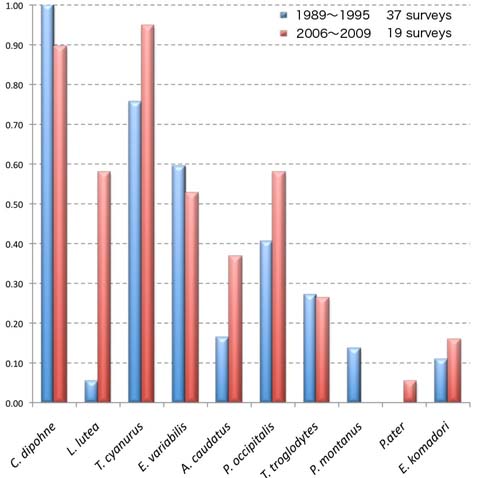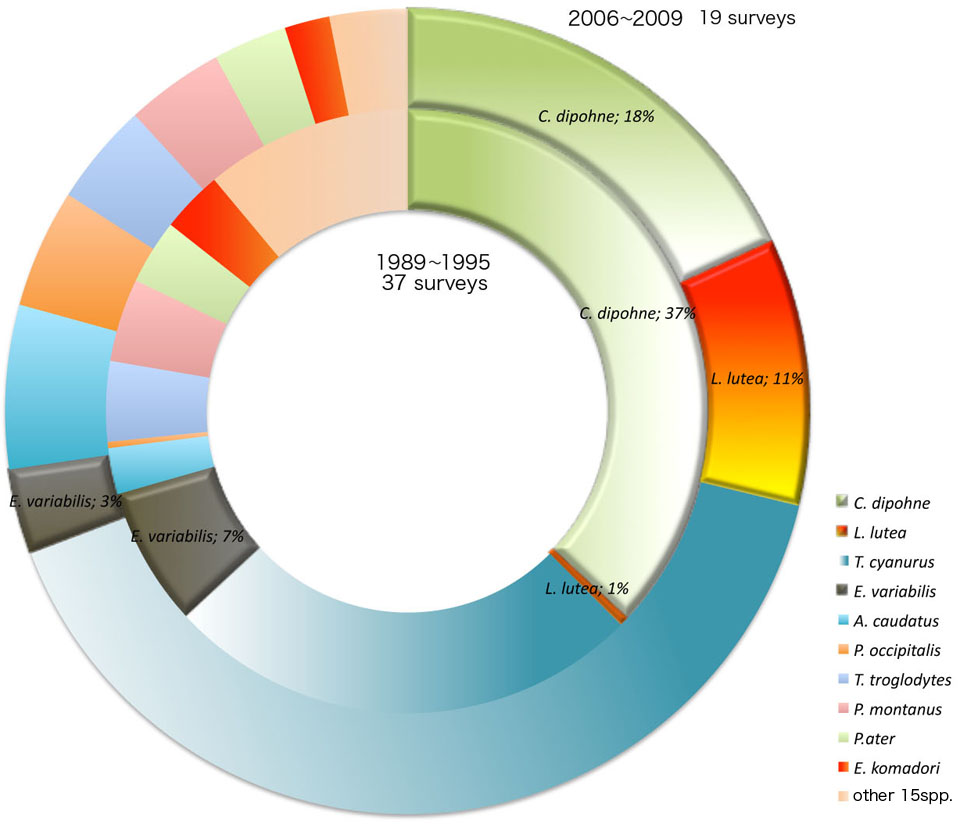
Banding survey at Tsundashi Path, Chichibu, Saitama, Japan (January 8, 2010.1.8, revised)
location:altitude:1650m;N 35d 55m 17.6s / E 138d 48m 30.8s (WGS84) map->Copyright (C) 2007 Yahoo Japan Corporation. All Rights Reserved.
Period : May〜October, once or twice a month, an evening and a morning sessions each
trapping with 30mm、36mm、60mm mesh - 12m(W) x 2.4m (H) mist nets, usually 10 nets at once
fitting metal rings of the Ministry of the Environment, on the leg, measuring the morphology, and take pitures
measuring parts:weight, wing length (right/left), tail length (to the tip), tarsus length (right/left), culmen length, bill lenght (from the the posterior edge of the right nostril to the tip), bill depth, bill width (at the posterior edge of the right nostril)
* We take a mono-rail up to 1610m ridge, then wak up a little to the survey site. We sleep in tents. The ridge is covered thin with almost primary mixed forest. We wait for bird capturing or spend night with a fire, talking on the researhes. We are very busy when families of L. lutea, A. caudatus, or C. dhiphone.
Those who hope to support this pleasant survey (, who should be physically and mentally healthy; also have some ornithological knowledges and/or enthusiam for nature conservation) can contact to me with an e-mail.
Objectives:
1. Provide information of birds and ecosystems at the high altitude mountains, where the data is rather short. We like to detect the 20-year change. We also recorded the nature sounds with an IC recorder here, too (see ADAM page).
2. We recorded the alien bird Leiothrix lutea first on August 30, 1989. It was one of the earliest records of this species inhabited in natural forests in Japan. We shall monitor the state of this species in the forest, and estimate its impact on the bird community and the ecosytem.
3. Sika deer Cervus nippon has increased its density in the last decade. The deer feeds on the bamboo grass Sasamorpha borealis, the dominant undergrowth of the forest around the mountainous area. The dense growth of the bamboo grass is a significant habitat for Cettia diphone, L. lutea, Emberiza variabilis, Luscinia cyane and other several birds. We shall estimate the indirect effect by the deer to the bird community.
4. There is a possiblity that we can onserve a mast flowering and the following large area diappearance of S. borealis at the site. There is an information of that phenomena in late 1940's here. If it actually occures, then it is a good chance to observe a dramatic dynamics of the forest ecosystem.
Totally 25 species of birds were captured, the accumulated captures were 1,213 times.

↑ occurence rate(1st term - 37 surveys, 2nd term - 19 surveys)
Cettia diphone and Tarsinger cyanurus are the most dominant native undergrowth species.

↑simply accumulated capture times
During the first term, we captured two L. lutea on Aug. 30, 1989, and another on July 27, 1994.
In the first term (recently), L. lutea is the third dominant bird here. On the other hand capture of C. diphone has decreased.
Nowe (in 2009) we here the song and calls of L. lutea every time. Ten of the 39 captured birds were L. lutea in the survey of August, 2007.
** NEW ** There is an aural presentation (in English) at the annual meeting of Ecological Society of Japan in March 2010.
Abstract
Leiothrix lutea, an alien bird species in Japan, is now dominant in the natural forests. The author first recorded it in 1989 at a mixed natural forest of Chichibu mountains, near the center of Honshu Island of Japan. We caught 605 birds in 37-time mist net surveys during 1989 - 95, and 608 birds in 19 surveys during 2006 - 09. All the surveys except once, were consisted by an evening and morning sessions with about ten 12m x 2.4m nets. Of those, L. lutea was three and 65 in the capture number in each term, and twice and 10 times in occurred frequency. While Cettia diphone, which may be a competitive species, was 224 and 110 birds, or 37 and 17 times in each term. L. lutea has apparently increased its number and become a dominant species in this forest undergrowth bird community, while C. diphone has decreased its density, though the latter is still one of the most dominant birds. Emberiza variabilis, a constant summer resident, was 45 and 22 birds or 22 and 10 times in frequency, and it had also decreased its density. It is not clear that L. lutea's has an impact on the two native birds, because there were other environmental changes such as the increases of temperature and Cervus nippon, and maybe the decrease of Sasamorpha borealis. The author thinks the ecosystem change during the last two decades is at least directional, and the alien bird plays a role.
- end